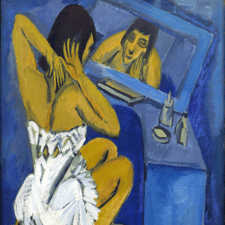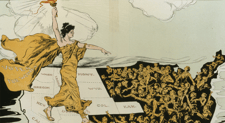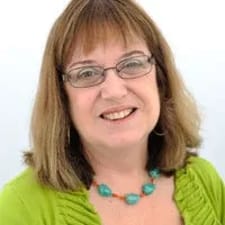And thus I became a woman.
Once upon a time, “she” was the default.
By Kathryn Lynch
“Toilette - Woman in Front of a Mirror” by Ernst Ludwig Kirchner. Wikimedia Commons, licensed under CC BY 3.0.
At first—long ago—I didn’t think much of “being a woman.” In both senses of that idiom. I didn’t think much about it. And when I did think about it, I didn’t especially think much of it. It came with problems, however trivial and surmountable. To the extent that I was aware that boys had advantages (and in those days they really did), I cast myself as a barrier-breaker. Fewer girls on the playing field, more glory for me.
But then came graduate school. I was no longer the neophyte able to downplay sex difference. My years toward the PhD taught me that “being a woman” was something I’d need to stash away to be successful. I’d become not just a “neutral” woman but a fully-sexed mother of two tiny children. The larger my pregnant belly, though, the more invisible I was to my graduate school “mentors” (all men). Don’t get me wrong: I loved being a young mother. But I didn’t love watching my male grad-school colleagues marching off to all the jobs, or the young women dropping out.
But, despite my small awakening, I still had not affirmatively “become a woman.”
I’ll even tell an embarrassing story to highlight my cluelessness. It was 1982, 43 years ago. I was being interviewed to teach in the English Department at Wellesley College. Wellesley is proudly the #1 women’s college in the U.S (perhaps the world). So, it should have been no surprise that I was asked what difference teaching all women would make for me.
But I was flummoxed. Until that moment, I hadn’t realized that Wellesley was a women’s school. I’d perused the whole catalog in the public library on microfilm and somehow managed to miss the most important point. A product of a large public high school and two big Research 1 universities, I’d never considered going to a “girls’ school” myself. Women’s education was just not on my radar. So I gave the only answer I could, which was that I didn’t expect teaching women would make much difference. Apparently, that answer was ok—it was egalitarian and, I guess, showed respect for the capabilities of the students. Anyway, I got the job.
But I see now that my answer could not have been more wrong. The first department meeting I attended happened in the spring before I started teaching, during a house-hunting visit to New England. Sitting in on the edges of that meeting, I was startled by—of all things—the pronouns, which didn’t attract the attention then that they do now. At Wellesley, “she” was the default. Every student was “she.” This was new to me. In my dissertation (and first book) I’d fallen back on the default “he” (even using the word “mankind”). One of the early reviews of the book called me on this, though I thought it was a nothing issue. But, once I’d heard that “she,” it suddenly mattered a lot to me that the feminine pronoun could stand in for the universal.
Other changes went deeper. Suddenly, at Wellesley, I no longer had to hide my womanhood. Women were all around me, as my colleagues, as leaders in the college. But most importantly, as 100% of the students I was charged with educating. I discovered that I had a reach of experience I could draw on and understand in a new way. I was not simply a mother and a scholar but a role model for my students of how these two could support one another.
Over the many years since then, my femaleness has become a key part of my identity as a teacher. In an all-women’s classroom (even as a medievalist), I discovered there were all sorts of taboo things we could discuss differently in the absence of men: how Simone de Beauvoir’s equation of women and death plays out in medieval poetry; how the modern pop-culture Beowulf manifests an obsession with the erect penis; how many different kinds of blood Chaucer might be referencing in the Wife of Bath’s bed—and why they mattered. I could also take an occasional break from our subject matter to deliver some hard truths about a woman’s life—for example, how the students’ tendency to procrastinate might interfere with a goal of combining family and professional lives, if that was their goal.
I discovered there were all sorts of taboo things we could discuss differently in the absence of men.
My students became dear to me. I learned to respect choices they made that were different from my own (same-sex partnerships, economics majors). I stopped thinking competitively; the success of one was the success of all. I became a great teacher.
But I still hadn’t fully, intentionally “become a woman.”
More recently, many of these womanly advantages have evaporated. Today at my women’s college, “she” is no longer the default pronoun. Instead, the professionals in our student life division tell us to solicit “pronoun preferences” at the beginning of classes or meetings. Some students go by “he”; many by “they.” If I get their pronouns wrong, they let me know it.
There are students who want us to stop referring to our graduates as “alumnae” (the Latin feminine form) and revert to the Latin masculine default “alumni” (as more “inclusive”); they go by “mx” rather than “ms.” We no longer crown America’s good with “sisterhood” when we sing “America the Beautiful”—a previously common local emendation of this hymn written by Wellesley alumna and professor Katharine Lee Bates. Now, though scattered faculty and staff still faintly chant “sisterhood,” our students loudly cheer “siblinghood”! I have been told that students avoid me because I still talk about “women” in an unapologetic way; reportedly I “give off TERF energy.”
And that’s how, in my seventh decade of life, I finally “became a woman.”
Not until the category fell under threat—until something I’d come to value was being taken away—did I realize how vital my womanhood was. That it was central to my life in all its aspects. Even as I’ve made that journey, many of my students—now fifty years younger than I am—appear to regard sex as voluntary and fungible. This creates distance between us.
And yet they resemble my own younger self, imagining that their sex does not matter. Some of them wish to erase it—through language and sometimes through medical transition. I don’t presume to deny them these rights. But looking back, I want to encourage these young women to spend more time understanding the ways that embodied sex is an essential element of human experience.
Being a woman—with all the miracles and disabilities that entails—brings challenges. But 42 years of experience at an institution that puts “being a woman” at its center has made me one in a way I never anticipated. The irony is that, even as I want to communicate this history to my students, many of them have put themselves out of reach.

Men and boys—with all the problems they face today—seem to talk with each other more easily across generations. Women remain competitive, apparently regarding feminist advancement as a zero-sum game. Third-wave feminists deny their second-wave mothers, even as we second-wavers failed adequately to acknowledge the suffragettes. That may be at least partly because compared to the male life span, the female one includes so many different seasons (youth, childbearing, menopause, and beyond), and it’s scary to acknowledge that new and harder chapters of life lie ahead. For women, change is the order of life. One doesn’t “become a woman” just once, but many times, and in different ways.
The misfortune is that it takes a lifetime’s experience to learn this, and then it is a lesson not easily passed forward.
